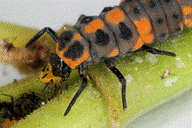Papers in the Biological Sciences

Brigitte Tenhumberg Papers
Document Type
Article
Date of this Version
2014
Citation
Published in Oecologia 175 (2014), pp. 129–138; doi: 10.1007/s00442-013-2876-4
Abstract
The influence of native fauna on non-native plant population growth, size, and distribution is not well documented. Previous studies have shown that native insects associated with tall thistle (Cirsium altissimum) also feed on the leaves, stems, and flower heads of the Eurasian congener Cirsium vulgare, thus limiting individual plant performance. In this study, we tested the effects of insect herbivores on the population growth rate of C. vulgare. We experimentally initiated invasions by adding seeds at four unoccupied grassland sites in eastern Nebraska, USA, and recorded plant establishment, survival, and reproduction. Cumulative foliage and floral herbivory reduced C. vulgare seedling density and prevented almost any reproduction by C. vulgare in half the sites. The matrix model we constructed showed that this herbivory resulted in a reduction of the asymptotic population growth rate (λ) from an 88% annual increase to a 54% annual decline. These results provide strong support for the hypothesis that indigenous herbivores limit population invasion of this non-native plant species into otherwise suitable grassland habitat.
Included in
Biodiversity Commons, Biostatistics Commons, Entomology Commons, Environmental Monitoring Commons, Other Plant Sciences Commons, Population Biology Commons, Survival Analysis Commons, Systems Biology Commons


Comments
Copyright © 2014 Springer-Verlag Berlin Heidelberg. Used by permission.